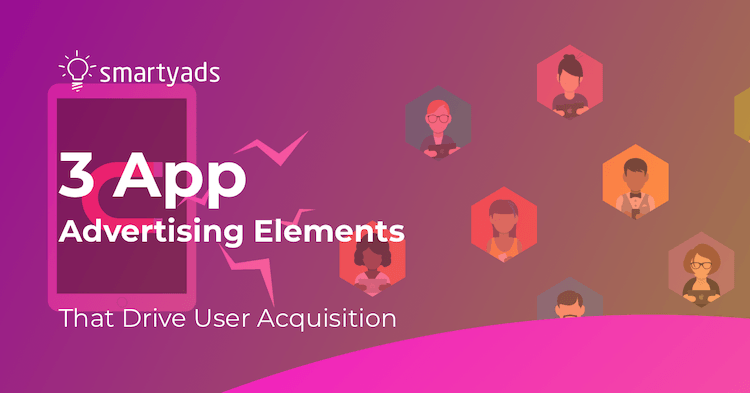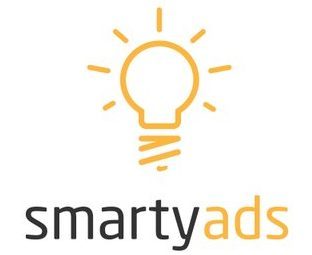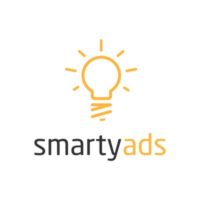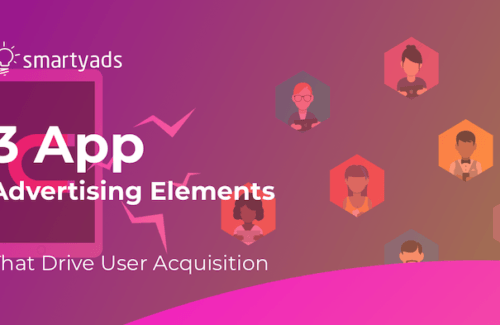
The market of mobile applications is expanding exponentially, at the same time, the methods, formats, and strategies of in-app ad promotion never fails to catch up. Being professionally involved in programmatic advertising, SmartyAds speeds up the process of sharing the mobile user acquisition methods that will be specifically effective for in-app promotion in 2018.
The hardships of mobile advertising
As the app market continues to grow, so does the average cost per user acquisition. In the competitive modern mobile ecosystem, the acquisition cost varies from $4 to $8 and more than $65 for the user that regularly commits in-app purchases. Acquiring a full-time subscription user is something that will cost developers a whooping $162 per year.
While establishing own application on the worldwide scale isn’t seen as a challenge, but as an advantage, the app developers start facing the new difficulties. For instance, trying to avoid the fierce competition, the app marketers try to attract users from developing markets. Discovering the new users in such countries like China, Russia, or India appears cheaper; but targeting them becomes tough due to the outdated operating systems, devices and slow network speeds.
In 2018, the leading app marketers and advertisers actively use a whole range of methods and advertising strategies that not only are capable to improve the user acquisition and decrease its cost but also contribute to better retention.
Choose the right ad format
It’s important to determine which ad formats you want to choose to promote your app. In fact, in 2018, the app marketers are mainly torn between 4 popular in-app ad formats: videos, playables, rewarded, and good old banners. These formats require different technical capabilities before integrating into the application so it’s better to make sure the advertising platform is able to deliver them in a high-quality resolution.
Rewarded ads. These types of ads were initially designed to avoid ad blockers. Striving to obtain valuable in-app rewards in exchange for their attention, the users voluntarily engage in advertising watching. After the promotion video is completed, the gamer typically obtains incentives like: extra life, the weapons, and hints in the game or bonus hours of music listening (content) in apps. According to our data, this format is a leader in terms of eCPM on IOS (10,34) and Android (8,36) platforms.
Playable ads. With interactive ads, it is fairly easy to track down the user experience in order to understand why the creative possibly underperforms. Playable ads offer to try the short version of the new game to allure the users for further installation. Playable ads drive eCPM on the level of $15,24 and help to improve retention on 30-40%. Since the users are accustomed with the gameplay, they are less likely to delete the app right after downloading.
Video ads. The demand for the “video advertising” has never ceased to raise even after interactive ad formats captured in-app market. With technological advent, small advertisers are able to make commercials that easily compete with TV advertising in terms of efficiency. Some experts believe, that video advertising is a new convenient type of user acquisition. In just 15-second videos, the brands deliver a lot more information than with static formats. The ad platforms that support VPAID or VAST formats allow tracking the advertising campaign results and general video performance.
Banners. Compared to videos, the banners are usually cheaper; on the other hand, they often interfere with the user’s experience in the app, causing annoyance. Today, however, banners are not limited to static square notifications, there are interstitial and rich media banners that support in-build interactive creatives. Furthermore, if you target an audience in developing countries, banners can be the best choice that will guarantee success with the creative rendering on devices.
Differentiate your targeting
The above mentioned information illustrates, there is no single format that is able to suit all campaigns equally because they need to meet individual campaign criteria: the goals, budget, and the target audience.
Dig deeper in order to understand how to target your audiences better, the rest of it is just a matter of technology. For instance, the iOS users in the US will react differently than Android users in India; so you need to differentiate your advertising by geography and devices. Additional efforts directed towards better acquisition will also make sense. Thus, when making ASO promotion inside the app stores don’t forget to mention genres or attribute the app to several ones if gameplay allows.
Ultimate App Growth Guide 2025
Boost your app’s success with the Ultimate App Growth Guide! 🚀 Expert insights, proven strategies & must-know tips. Download now!
Master app growthIn case you promote the mobile game, ask your tech provider for detailed app campaign analytics. This way you can assess the highest and lowest conversions in your segment and know for sure what to expect beforehand. You can go even further; find out which apps of yours have the highest LTV and increase the user acquisition efforts for them.
Optimize after launch
Don’t neglect using analytics while you study the user experience inside the app. Track the path from the moment the ad is displayed until the moment the user commits to an installation or clicks on the ad. Find out your most converting audience, and focus your efforts on their retention. Identify the behavior patterns of this audience in the early stages of the ad campaign launch (targeting by gender, age, geo, device, message, CTR).
It is crucial to optimize not only the ad purchasing, targeting, and creatives, but also the user behavior from impression to install, including the cases when viewers did not convert the first time.
Thus, for instance, our client was a mobile app developer who barely reached 100 installations per month. Buying large amounts of traffic or aiming to the top was quite difficult with this. The developer needed to come up with a model in which the ads would be shown only to their most converting 22-29 year old audiences living in US.
Connecting the new programmatic targeting tools is what helped to increase an installation growth of 280% in a month. During that month, they additionally launched the playable ad format as a part of retargeting users and achieved an additional 45% traffic growth.
To sum up
Understanding which creatives and audiences work best for you mobile application’s promotion is a key to developing a robust user acquisition strategy. The big data and programmatic technologies make it possible to direct advertising towards your most valuable audiences and appeal to them with the relevant message at the right time.











